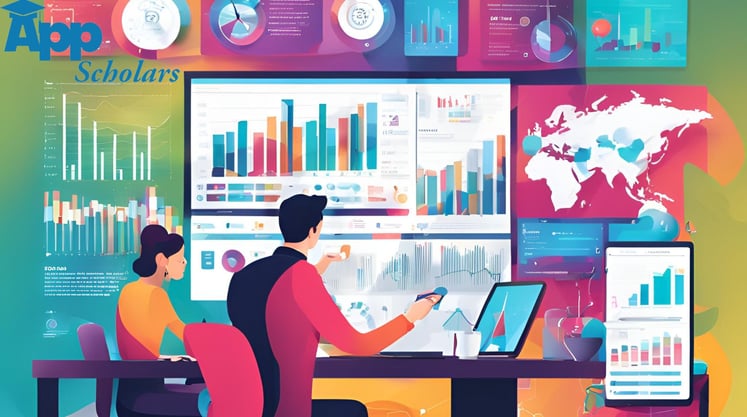Revolutionizing Web Development: The Latest Techniques and Technologies in Design and Tech
Revolutionizing Web Development: The Latest Techniques and Technologies in Design and Tech
WEB DEVELOPMENT
App Scholars
4 min read


The digital realm is in a perpetual state of evolution, and web development sits at the heart of this dynamic transformation. Today's web isn't just about information dissemination; it's about immersive experiences, instant gratification, and intelligent interactions. Let's embark on a journey through the cutting-edge techniques and technologies that are redefining both the design and technical landscapes of web development.
1. Jamstack Architecture: Redefining Web Infrastructure
Traditional monolithic architectures are making way for the Jamstack paradigm—an architecture designed for speed, scalability, and enhanced developer experience.
JavaScript, APIs, Markup (Jam): By decoupling the backend from the frontend, developers can build dynamic websites using static site generators and APIs.
Performance Boost: Pre-rendered static pages served over CDNs drastically reduce load times.
Enhanced Security: With fewer server-side processes, the attack surface diminishes, resulting in more secure applications.
Scalability Simplified: Scaling is as effortless as serving static files, accommodating traffic spikes without a hitch.
Why it matters: In an era where milliseconds matter, Jamstack provides the infrastructure to meet user expectations for lightning-fast experiences.
2. Progressive Web Apps (PWAs): Bridging the Gap Between Web and Mobile
Progressive Web Apps blend the best of web and mobile applications, providing users with an app-like experience directly in their browsers.
Offline Functionality: Service workers enable caching of assets and data, ensuring functionality without an internet connection.
Native Features: PWAs can access device hardware and features like push notifications and geolocation.
Installation-Free: Users can 'install' PWAs to their home screens without the friction of app stores.
Design implications: PWAs necessitate a mobile-first design approach, ensuring seamless usability across devices.
3. Micro Frontends: Scaling Frontend Development
As applications grow, the monolithic frontend becomes a bottleneck. Micro frontends offer a solution.
Modularity: Break down the frontend into smaller, manageable pieces that can be developed, tested, and deployed independently.
Team Autonomy: Different teams can own different micro frontends, fostering parallel development.
Technology Agnostic: Teams can choose the best tools and frameworks suited for their component.
Challenge: Maintaining a consistent user experience requires robust design systems and cross-team collaboration.
4. Serverless Architecture: Focus on Code, Not Infrastructure
Serverless computing allows developers to build and run applications without worrying about server management.
Cost-Effective: Pay-as-you-go model charges only for the compute time consumed.
Auto-Scaling: Automatically scales with demand, handling sudden traffic spikes effortlessly.
Accelerated Development: Quickly deploy functions without provisioning servers.
Impact on development: Encourages the use of Function as a Service (FaaS), leading to decoupled and event-driven architectures.
5. AI and Machine Learning Integration: Intelligent Web Applications
Incorporating Artificial Intelligence (AI) and Machine Learning (ML) into web applications is becoming mainstream.
Personalization: Deliver tailored content and recommendations based on user behavior.
Chatbots and Virtual Assistants: Enhance customer service with AI-driven conversational interfaces.
Data Analytics: Gain insights from user interactions to inform business decisions.
Design considerations: Balancing personalization with privacy—transparent data practices build user trust.
6. Motion Design and Micro-interactions: Engaging User Experiences
Incorporating motion design enhances usability and delight.
Micro-interactions: Small, subtle animations that provide feedback, such as button hover effects or loading indicators.
Guided Focus: Animations draw attention to key areas, improving navigation.
Brand Personality: Motion conveys brand values and improves recall.
Balance is key: Overuse can distract; animations should serve a functional purpose.
7. API-First Development: Building for Flexibility
An API-first approach prioritizes the design and development of APIs before building the frontend.
Separation of Concerns: Frontend and backend can evolve independently.
Omnichannel Delivery: Serve content across web, mobile, and IoT devices seamlessly.
Scalability: Microservices communicate via APIs, promoting a modular architecture.
Tooling: Use of tools like GraphQL for more efficient data fetching.
8. Edge Computing: Bringing Data Closer to Users
Edge computing processes data at the network edge, reducing latency.
Speed Enhancement: Closer proximity to users accelerates load times.
Reduced Server Load: Offloads processing tasks from central servers.
Real-Time Processing: Crucial for applications requiring immediate data analysis.
Use cases: IoT applications, real-time analytics, and content delivery.
9. Advanced CSS Techniques: Elevating Design
CSS has evolved, empowering developers to create complex layouts and effects natively.
CSS Grid and Flexbox: Simplify responsive design with flexible, grid-based layouts.
Custom Properties (CSS Variables): Enable dynamic theming and easier maintenance.
Blend Modes and Filters: Create sophisticated visual effects without images.
Design freedom: These advancements reduce reliance on JavaScript for styling.
10. Static Site Generators and Headless CMS: Content, Redefined
Combining Static Site Generators (SSGs) with Headless CMS provides performance and flexibility.
SSGs: Generate static HTML pages at build time, enhancing speed and security.
Headless CMS: Manage content separately from the frontend, accessible via APIs.
Dynamic Content: Use techniques like Incremental Static Regeneration (ISR) for real-time updates.
Popular tools: Next.js, Gatsby, Contentful, Strapi.
Embracing the Synergy of Design and Technology
The intersection of design and technology is where innovation truly happens.
Design Systems: Unified guidelines for UI components ensure consistency and efficiency.
Collaboration Tools: Platforms like Figma and Adobe XD facilitate real-time collaboration between designers and developers.
User-Centered Design: Ground all technological decisions in the needs and behaviors of users.
Remember: Technology should serve design objectives, enhancing the user experience.
Conclusion: The Web's Next Frontier
We're standing at the precipice of a new era in web development, where the fusion of innovative technologies and thoughtful design is creating experiences we've only dreamed of.
Artificial Intelligence will continue to personalize and enhance interactions.
Augmented Reality (AR) and Virtual Reality (VR) are poised to revolutionize how we perceive and interact with web content.
Ethical Considerations around data privacy and accessibility will shape responsible development practices.
Your role: As a developer or designer, you have the power to shape the future of the web. Embrace these technologies not just for what they can do, but for how they can empower users and enrich lives.
Ready to shape the next generation of web experiences? Let's push the boundaries together and create a web that's faster, smarter, and more inclusive than ever before. What's your take on these advancements? Are there any technologies you're particularly excited about or challenges you've faced implementing them? Contact App Scholars at sales@appscholars.com and let's dive into a conversation and explore the possibilities.

Innovative Software Solutions For Your Needs
sales@appscholars.com
© 2025 App Scholars Tech Solutions. All rights reserved.
